Content delivery networks (CDNs) are widespread these days. This is quite understandable: the number of Internet services with a global audience is growing, and almost all such services are in one way or another related to the delivery of heavy (photo, audio, video, and other) content.
The number of Internet users, especially mobile ones, is growing every day, and the creators of websites and applications quite naturally think about ensuring fast work anywhere in the world. Demand creates supply – and the number of companies offering CDN services is also constantly growing. It is enough to type in the corresponding query in Google – and a huge number of advertisements will be presented in the search results.
How to choose a really high-quality CDN provider? What to look for first of all?
We will analyze these questions in detail below. The outline of our presentation will be as follows: first, we will try to formulate the selection criteria, and then, based on these criteria, we will compare the most popular providers.
Criteria of choice
Let’s try to derive some more or less universal criteria for choosing a CDN.
The first and most obvious criterion is the number of points of presence in different regions. The more points of presence in different regions of the world, the higher the speed and wider opportunities for content delivery.
The second criterion is the number of connections with telecom operators. The more joints, the shorter the response time. Usually, CDN providers do not publish such information, and everything can be found out only through testing. Here, let’s pay attention to the number of peering partners – the more there are, the higher the content delivery speed.
The third criterion is support for technologies and protocols (HTTP/2, IPv6, SSL certificates, and others). Usually, modern CDNs support all of this, but nuances are possible, especially when it comes to small providers.
The fourth criterion is the availability of additional services and functions (availability of REST API, plugins for websites and mobile solutions, provision of “raw” logs, analysis of consumption statistics, etc.).
The fifth criterion is the availability of technical support, as well as the quality of documentation and training materials (in different languages).
Mini-rating of CDN providers
Choosing providers for comparison is also not an easy task: the offer, as mentioned above, is very large. When choosing, we paid attention to the following:
- Number of points of presence around the world
- Availability of global web services among clients
- High positions in specialized analytical services and ratings (cdnperf.com, cdncomparison.com, Citrix analytical service).
The first four we have included providers that have already firmly taken their place in the global market:
- Akamai needs no introduction. It is one of the most famous and largest CDN service providers in the world. The company was founded in the USA in 1998. Today, the Akamai network includes about 275,000 servers located in 136 countries around the world. Clients include BBC, IBM, RedHat, Hewlett Packard, Airbnb, and other well-known companies.
- G-Core Labs is a Luxembourg-based company with an infrastructure of 100+ points of presence on 5 continents. Founded in 2011. In addition to CDN services, it also offers hosting services (physical and virtual servers), custom streaming, public and hybrid clouds. Famous clients include Wargaming, Metro cash & carry, Avast, TED, GetCourse, RedFox Games.
- CloudFront is another CDN operator that needs no introduction: Amazon. The network includes 225 points of presence in many countries of the world. The services of this CDN are used by Slack, Canon, Discovery Communications, and others.
- Cloudflare is another well-known American hosting company. CDN has been providing services since 2010. Among the well-known clients of the company are Tinder, Udemy, Medium.Com, and others.
The next three providers are companies that are actively developing and have a chance to squeeze the just named leaders:
- Fastly is an American cloud provider. Has offices in the United States and London. Points of presence are located in the USA, South America, and Europe.
- CDN77 is a British company; has points of presence in more than 20 countries. Its services are often used by organizers of online broadcasts. Well-known clients include NASA, the educational service Udemy, the developer of the ESet antivirus, and the Sport1 TV channel.
- KeyCDN is a Swiss-based company with a focus on the European market. Founded in 2012. For almost 10 years on the market, it has managed to prove itself quite well; famous clients include Uploadcare, Discourse, Sennheiser.
Points of presence
We’ll start our comparative analysis of CDN operators with the most obvious and important criterion: the number and location of points of presence. We have compiled the analysis results in the form of a table:
| Provider | Europe | Asia | Africa | North America | South America | Australia and Oceania |
|---|---|---|---|---|---|---|
| Akamai | 40 | 58 | 24 | 46 | 39 | 15 |
| G-Core Labs | 31 | 23 | 5 | 14 | 9 | 2 |
| CloudFront | 63 | 57 | 7 | 37 | 3 | 9 |
| Cloudflare | 46 | 65 | 15 | 46 | 23 | 8 |
| KeyCDN | 16 | 9 | 2 | 10 | 4 | 5 |
| Fastly | 14 | >20 | 2 | >20 | 6 | 6 |
| CDN77 | 10 | 14 | – | 6 | 3 | 1 |
All information was taken from the official websites of companies and maps of points of presence, published in the public domain.
All figures are current as of early May 2021; It should be borne in mind that all CDN operators rarely publish lists of absolutely all points of presence in all cities and are constantly introducing new points of presence. Information about the planned points of presence, which is provided by some providers on the official websites, was included in the table.
An interesting conclusion can be drawn from a simple quantitative analysis of even this information.
Even a cursory glance at maps and tables is enough to make sure that in the modern world, Asia is one of the most promising and growing markets. Projects planning a major international expansion will clearly appreciate the extent of coverage in the Asia and Pacific region.
Of greatest interest are G-Core Labs and Akamai, with points of presence on all continents.
Number of connections with telecom operators
This parameter is very important. At the same time, this parameter turned out to be almost the most difficult to analyze: it is very difficult to find suitable information. Firstly, you can and should refer to the official websites of companies: there, for example, information on the number of peering partners is published.
Akamai, CloudFlare, Cloudfront and G-Core Labs are leading in terms of the number of partners. Each of these companies has more than 5,000 partners. The rest of the survey participants – from 1000 to 2000.
Secondly, all the companies we have selected for review can be verified using the PeeringDB service. There you can find to which traffic exchange points a particular company is connected and where its peer-to-peer equipment is installed.
Information on the number of traffic exchange points to which our survey participants are connected is given in the following table:
| Provider | IXP number | Number of peering partners |
|---|---|---|
| Akamai | 333 | 1700 |
| G-Core Labs | 157 | >5000 |
| CloudFront | 343 | no data |
| Cloudflare | 411 | >5000 |
| KeyCDN | not found | no data |
| Fastly | 245 | >1000 |
| CDN77 | 56 | no |
Speed tests
Let’s now try to compare the response time for all participants in our review. We used the Citrix analytics service to estimate response times. It collects data from users around the world and, based on this, calculates the average response time. Based on this data, collected over a period of time, he draws up graphs. This is how the chart for the last 30 days looks like (when assessing, we focus on the median value, i.e. the 50th percentile):
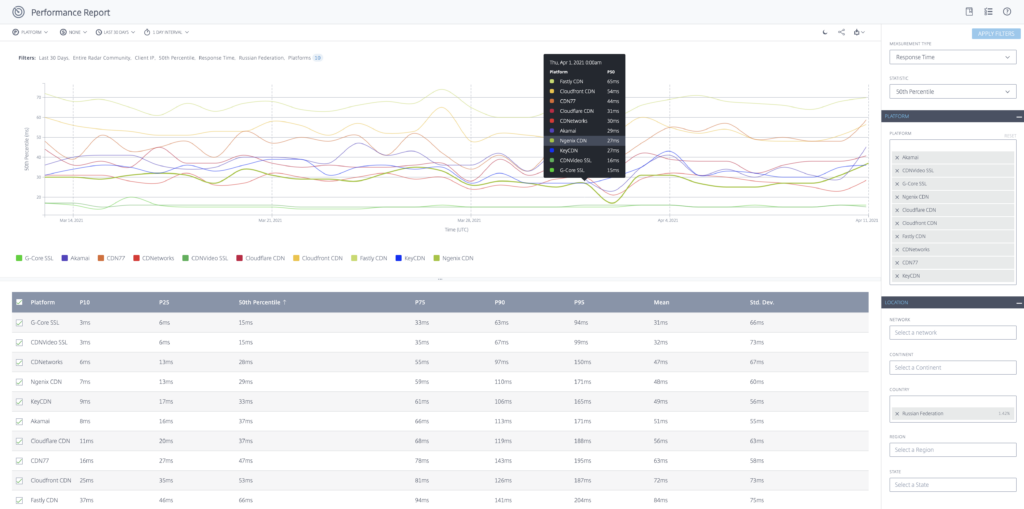
Now let’s look at the graphs of the response time in different countries and on different continents.
Germany:
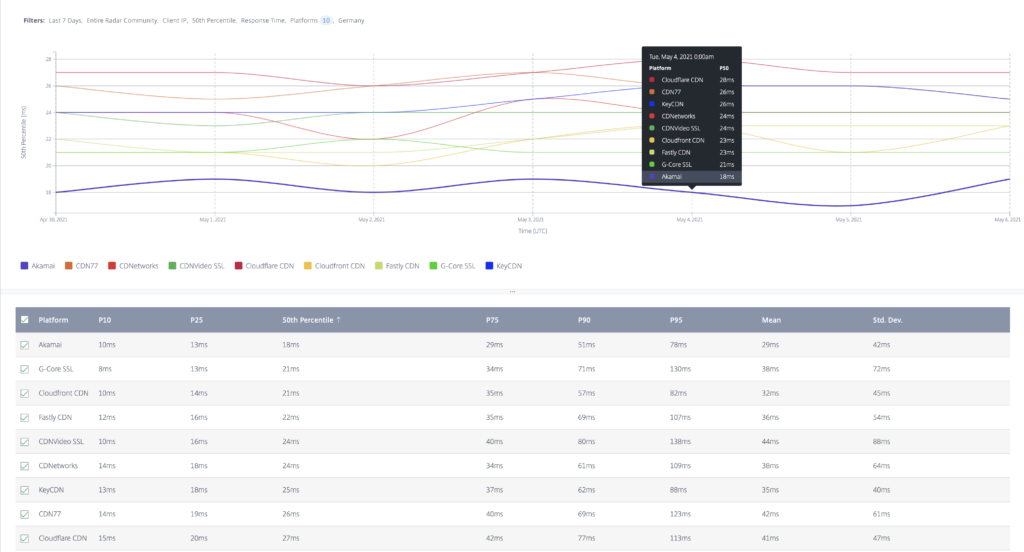
Izrael:
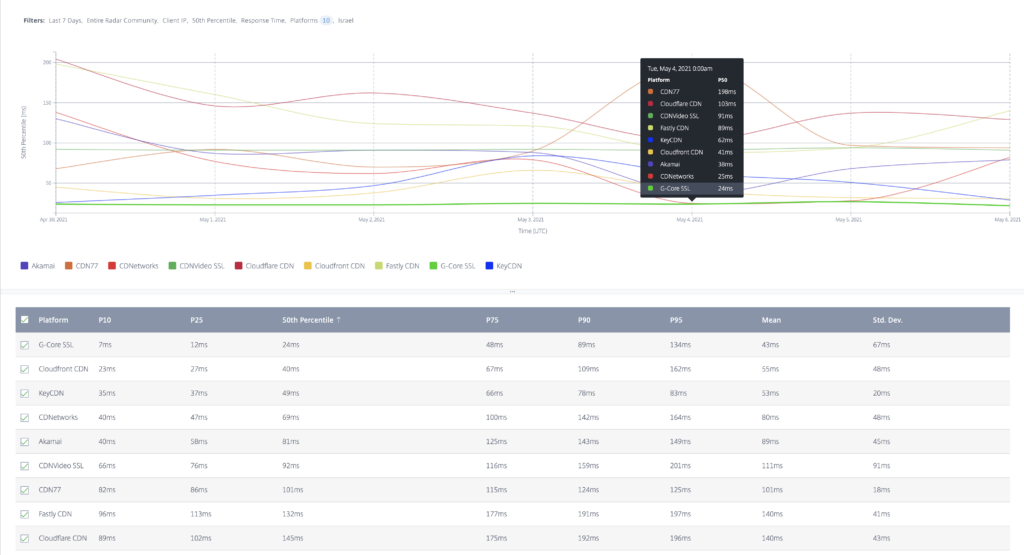
Netherlands:
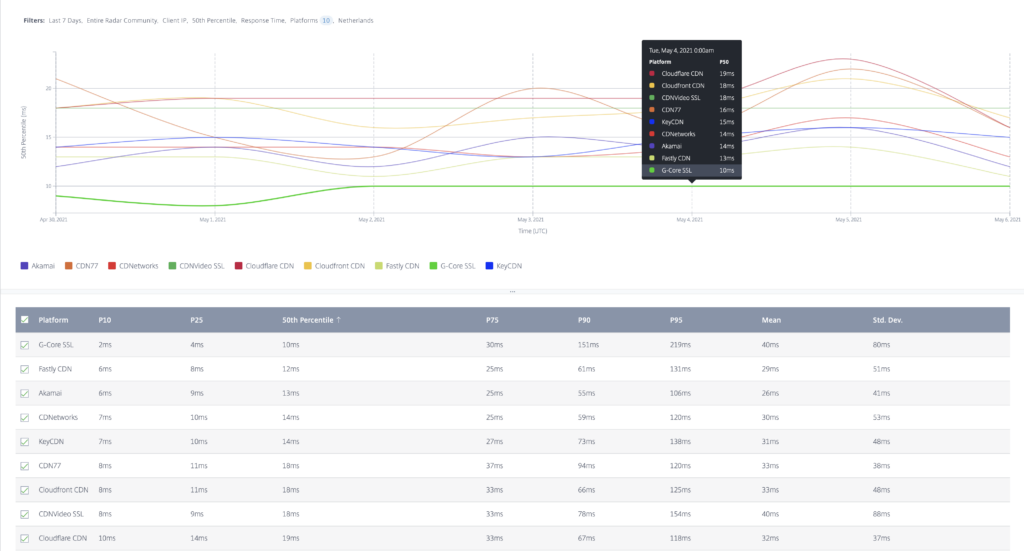
Poland:
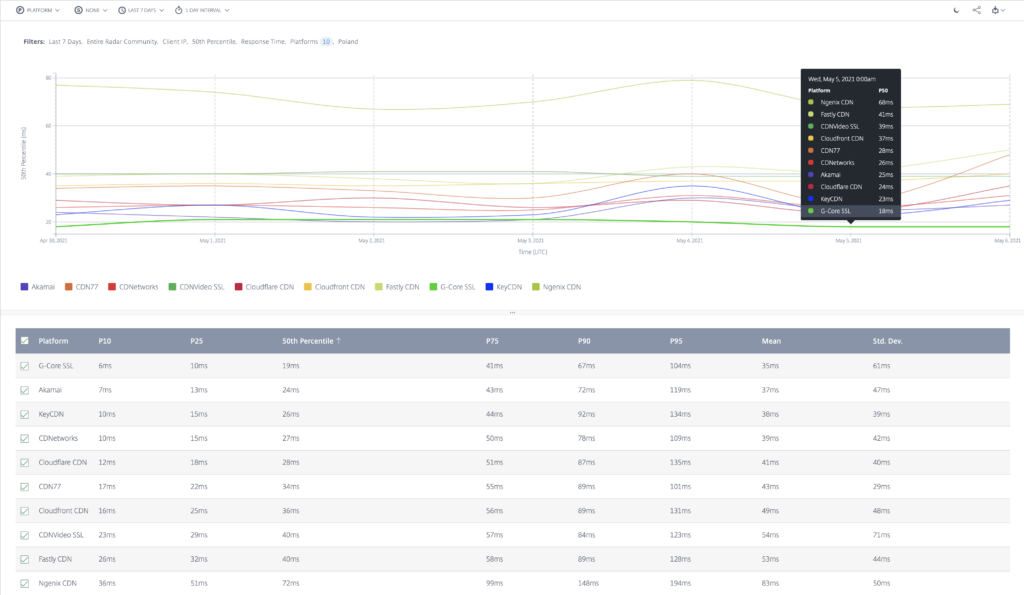
Great Britain:
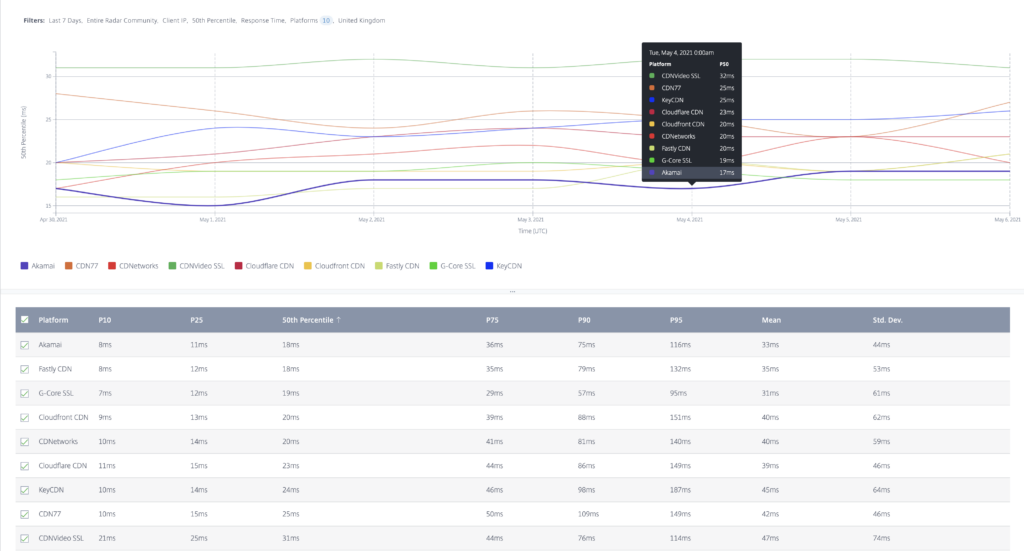
Japan:
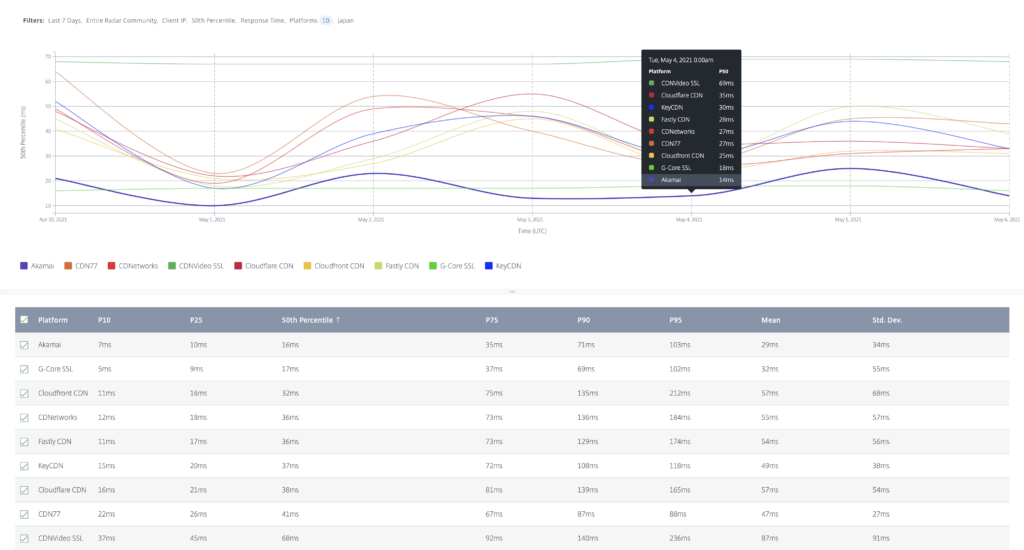
United Arab Emirates:
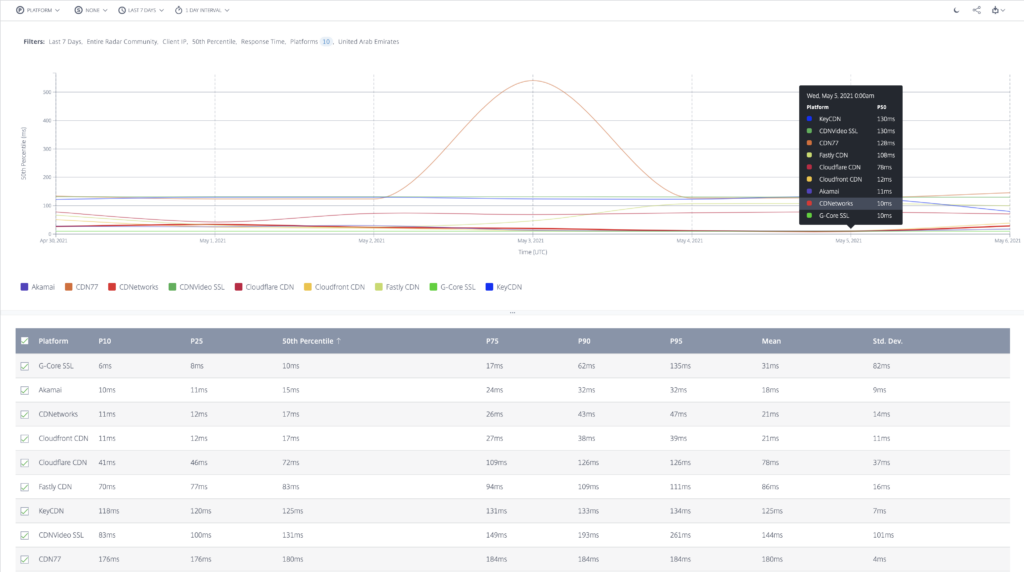
Armenia:
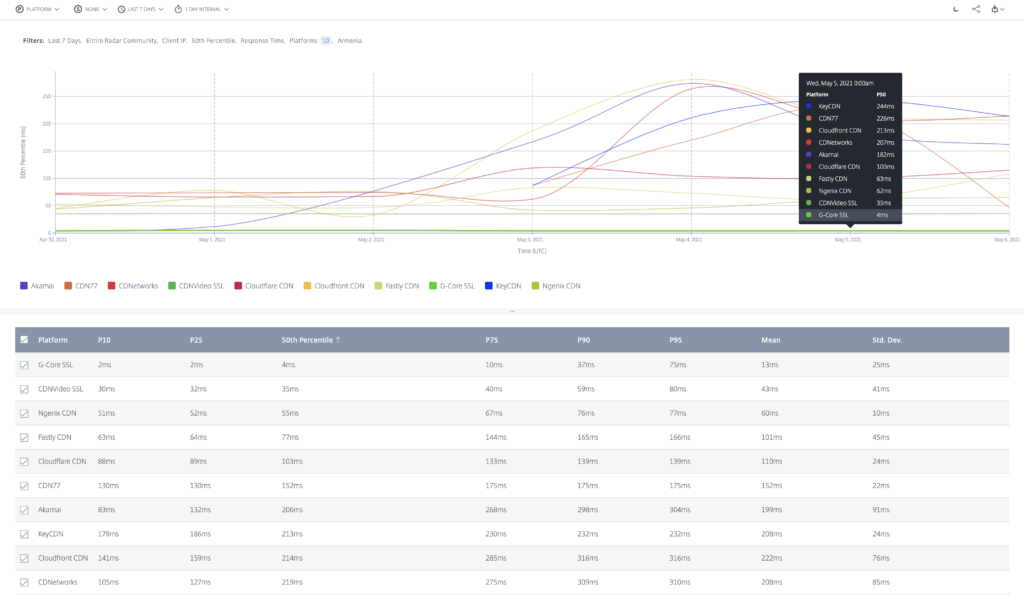
India:
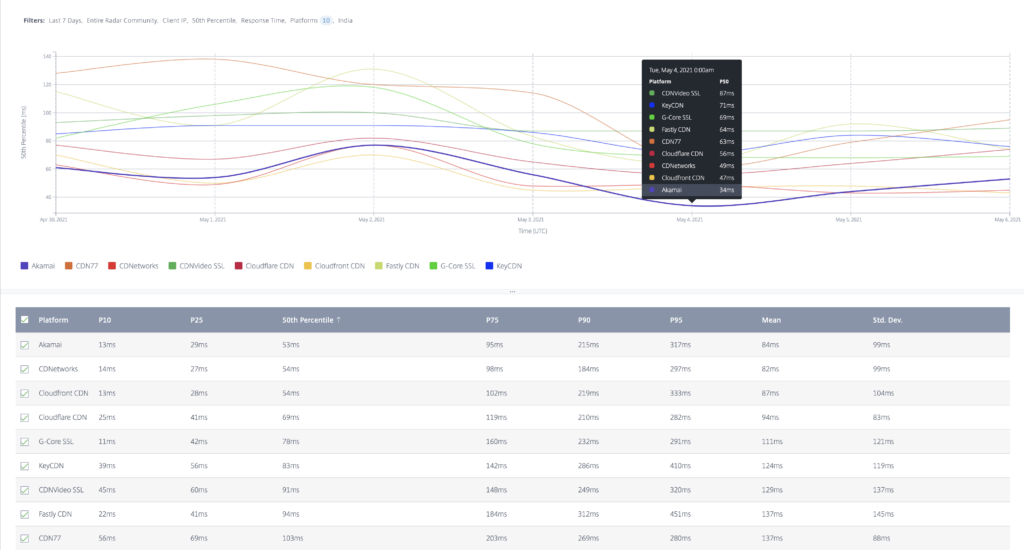
Brazil:
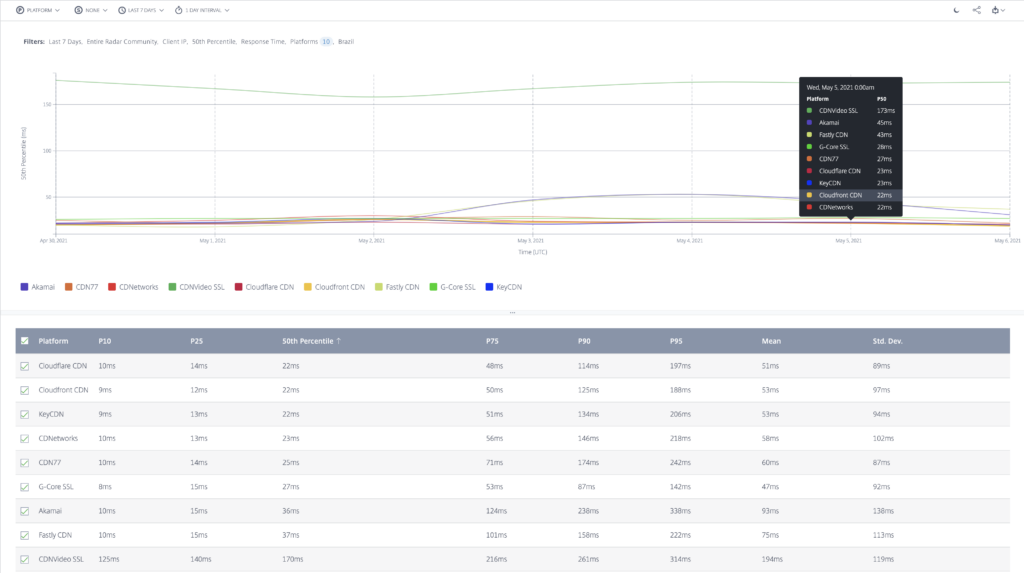
Features, functions, technologies
Most CDN providers provide roughly the same services and support roughly the same set of protocols and technologies. We will not make a detailed comparison, and this is not necessary.
We will focus only on the parameters that seem to us the most relevant and important in our time. All of them are somehow connected with the delivery of media content, as well as with the provision of additional security measures. The comparison results are in the table below.
| Functionality | Akamai | G-Core Labs | Cloudflare | CloudFront | Key CDN | Fastly | CDN77 |
|---|---|---|---|---|---|---|---|
| Technical support 24/7 | Yes, free | Yes, free | Yes, free | Yes, free | Yes, free | Yes, free | Yes, free |
| Public API | Yes | Yes | Yes | Yes | Yes | Yes | Yes |
| Plugins for CMS | Yes for Wordrpess, Typo3, October CMS and others. Basic options – free | Yes for WordPress и Bitrix | Yes for WordPress, Drupal, Magento and others | Yes for Wordress, October, Craft CMS and others | Yes for WordPress, Joomla!, СraftCMS | Yes for Droopal, Magento, WordPress | Yes for WordPress |
| Usage statistics CDN | Basic options – free | Yes, free + paid advanced analytics | Basic options – free | Basic options – free | Yes | Yes | Yes |
| Providing “raw” logs upon request | Yes, for a fee | Yes, for a fee | Yes, for a fee | Yes, for a fee | Yes, free | Yes, free | Yes, free |
| Origin Shield | Yes, free | Yes, for a fee | Yes, free | Yes, free | Yes, free | Yes, free | Yes, free |
| Web Application Firewall (WAF) | Yes, for a fee | Yes, for a fee | Yes, for a fee | Yes, for a fee | Yes, for a fee | Yes, for a fee | Yes, free |
| Defence from DDoS | Yes, for a fee | Yes, for a fee | Yes, for a fee | Yes, for a fee | Yes, for a fee | Yes, for a fee | No |
| Live streaming | Yes | Yes | Yes | Yes | Yes | Yes | Yes |
| SSL support | Yes, for a fee | Yes, free | Yes, free | Yes, free | Yes | Yes | Yes |
| Let’s Encrypt Integration | Yes | Yes | No | Yes | Yes | Yes | Yes |
Support and documentation
Prompt technical support is an important element of any modern service. As a rule, most modern companies provide technical support via chat, telephone and email. Most of the reviewers have it all, but some (for example, CloudFlare) provide support only for an additional fee.
An important criterion is the quality of the documentation. Good documentation will help the user to deal with many issues on their own, which in turn helps to optimize the work of technical support. Good documentation (including API documentation) pleased Akamai, CloudFlare, Cloudfront, G-Core Labs.
A little about usability
An important criterion when choosing a modern service is usability. The services of all CDNs described in our review can be managed through your personal account. Convenience of work and simplicity of the registration procedure are also quite important selection criteria. There are providers where, for registration, you first need to fill out a form on the website, after which a company representative contacts the user to connect the service.
For some, you can register on the site completely independently, without waiting for a call or letter from the company. A couple of providers also offer a free tariff – of course, with reduced opportunities compared to paid tariffs and a limited number of locations. But the very ability to register and instantly start using it is already a big deal; not all providers offer this.
Payment
Comparing tariffs is a rather complicated matter: not all providers publish the relevant information in the public domain. We have drawn up all available information in the form of the following table:
| Functionality | Akamai | G-Core Labs | Cloudflare | CloudFront | Key CDN | Fastly | CDN77 |
|---|---|---|---|---|---|---|---|
| Transparent pricing policy, availability of publicly available tariffs | Yes | Yes | Yes | Yes | Yes | Yes | Yes |
| Payment by consumption | Yes | Yes | Yes | Yes | Yes | Yes | Yes |
| Availability of a free plan | No | Yes | Yes | No | No | No | No |
| Free trial period | Yes | Yes | Yes | Yes | Yes | Yes | Yes |
Note also that almost all providers offer different tariffs depending on the region. When choosing a CDN, you need to consider which regions your project is focused on and in which regions it has the largest number of users. Accordingly, the decisive factors here will be the number of points of presence in these very regions + price.
If you have a small project, check out G-Core Labs and Cloudflare: they offer a completely free plan. Naturally, this tariff has limitations: G-Core Labs – in terms of traffic (1TB, and you need to pay extra for overruns) and the number of available locations (28), Cloudflare – in functionality (see the comparison of tariffs here) and support (in general not, except for user forums); additional options can be connected to this tariff, but for a fee.
Conclusion
In this article, we have compared several popular CDN services in a variety of ways. Now let’s try to answer another important question: which CDN is the best?
For international projects, Akamai and G-Core Labs, as well as Cloudfront and Cloudflare are suitable.
For small projects, it is better to start with free Cloudflare and G-Core Labs plans, and as you expand, think about switching to paid ones.